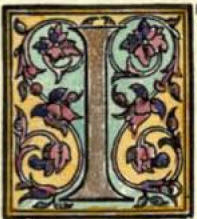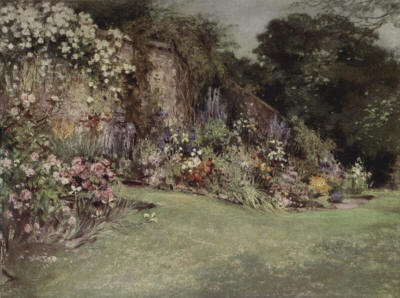|
 T
is a fancy of certain writers to give freak headings to their chapters,
cryptic enough, sometimes, but connected more or less vaguely with the
nature of the contents. Were that example to be followed in the present
unimaginative work, this chapter might be entitled "Cheese and
Chaffinches," to commemorate a pretty little scene enacted in that
fairyland which mortals call Barskimming. T
is a fancy of certain writers to give freak headings to their chapters,
cryptic enough, sometimes, but connected more or less vaguely with the
nature of the contents. Were that example to be followed in the present
unimaginative work, this chapter might be entitled "Cheese and
Chaffinches," to commemorate a pretty little scene enacted in that
fairyland which mortals call Barskimming.
The river Ayr winds
through the park, having cut for itself a profound channel through the
red Permian rock which overlies the carboniferous beds in all this part
of Ayrshire. The sides of the gorge are richly clothed with oak and ash,
which, as appears from Timothy Pont's survey, executed in 1595-1600, are
survivors of the primitive Caledonian forest; but here and there the
sides are sheer precipice, affording no foothold for trees, the crags
standing out bare, silvered with lichen or glowing with venetian red and
rose where the rock has crumbled away. In front of the mansion

house, which was rebuilt
after a fire some five-and-twenty years ago, a lofty and beautiful
bridge, designed by Robert Adam, has been flung across the chasm.
Of the four sisters who
have made Barskimming their home for a number of years, each has her
peculiar province and chosen outlet for energy. Miss Marianne Anderson
has established and made famous a stud of Welsh mountain ponies, a breed
whereof she was among the first to recognise the extraordinary beauty
and quality, and which has secured for her many honours at Dublin and
other horse shows. Miss Fanny Anderson's specialty is ornamental
ironwork, the garden gate, through which we shall pass presently, being
an example of the combined strength and delicacy of her handiwork. She
has also a remarkable power of attraction for wild birds. Whether this
be psychical, or whether it be purely physical, residing in a small tin
box stuck in her waist-belt, deponent sayeth not; he can but testify to
what he saw. Pausing on the bridge aforesaid on our way to the garden,
the bird-compeller sounded shrill summons to her familiars, and
forthwith there came from the dense foliage of an aged oak, whose
topmost branches were several feet below the bridge, a hen chaffinch, to
perch on the parapet within a yard or two of where we leant. A second
hen followed, and after her a cock bird, not quite so confident. Then
the magic box was opened, disclosing some tiny bits of cheese. One of
the birds was so tame as to take a piece of this delicacy from the very
lips of the lady ; but the favourite exhibition is obtained by flicking
a morsel of cheese over the parapet, when the chaffinches dart in
pursuit, one or other of them never failing to catch it before it
reaches the water eighty feet below.
But our main business at
Barskimming lies to-day in the garden, where Miss Bertha Anderson reigns
supreme, and thither she now guides us, through the pretty gate
mentioned above. Miss Bertha's collection of flowering plants has gained
wide repute, but before examining it in detail, a few words must be
devoted to describing the pleasaunce wherein they flourish, for it is
quite distinct in character from any other depicted in this book.
Through the heart of it the PowkailI [Celtic names cling closely to the
topography of the Lowlands. Powkail—the narrow stream—from the Gaelic
pot caol, containing the sane word as has been used for centuries to
denote the Kyles—that is the Narrows—of Bute.] has cleft a deep canon in
its haste to join the river which bounds the garden on the south. With
dubious taste, Lord Glenlee, the Scottish Lord of Session who laid out
these grounds 140 years ago, caused this stream to run for some distance
through a tunnel, filling up the dark gorge and levelling the surface as
a bowling green. The lower part of its course, which remains open, shows
how much natural beauty was sacrificed in this costly operation.
However, there it is; a fair space of level turf, partly shaded from the
south by splendid oaks of the true sessile-flowered kind, and bounded on
the other sides by sloping banks, terraced walks, and flower borders.
The north and west sides of the garden are protected by old and high
walls, once occupied by fruit-trees and a grape-house, but these Miss
Bertha has swept into limbo, draping the walls instead with sheets of
climbers, especially roses, among which may be noted the snowy Mme.
Alfred Carribre (well shown in Miss Wilson's drawing), the long
streamers of the original Loudon rose, putative parent of the numerous
progeny known as Ayrshire roses, and the Letton briar, a very uncommon
variety, with large, single flowers of clear, full pink.
Having got so far, the
visitor will have begun to realise some of the features which give its
distinguished character to this little valley of flowers. Chief,
perhaps, among these is the combination of a very dry surface with the
perennial presence of swiftly running water. No Eden is perfect without
its stream, and here gushing Powkail sounds ever in one's ears as it
hurries to the river through a deep and narrow dell, planted with choice
ferns and shade-loving plants. The Canadian Adiantum pedatum luxuriates
here ; Primula rosea attains a stature impossible under ordinary
conditions; the pretty foam flower (Tiarella cordifolia) runs riot among
the moist rocks, the yellow and orange forms of the Welsh poppy mingle
in charming contrast with the clear blue of Campanula rhomboidalis.
Rodgem as spread their noble foliage, meet companions for the native
wood bell-flower (C. latifolia) and the giant saxifrage (S. peltcata).
It is a place to make patent the futility and self-consciousness of so
many rock gardens; it is indeed inimitable by most gardeners, for the
foot of man can never have passed through this gorge until Miss Bertha
caused paths to be hewn out of the vertical rocks and flung a bridge
here and there across the chasm.
The license of flower and
foliage which riots in this dell throws into high relief the perfect
order and neatness maintained in the rest of the grounds. Neatness
without formality. There is not a gravel or paved path in the whole
garden; nothing but shaven sward on which you walk as upon velvet
pile—sward in green lagoons, as it were, across which splendid oaks
fling broad shadows—sward in smooth alleys between banks of summer
flowers which have succeeded the spring bulbs, now fast asleep in the
mould—sward in bays and corridors among choice rhododendrons and a few,
not too many, conifers. Here and there, in sunny nooks, stand pillars of
a peculiar kind, supporting large pots of geraniums. These pillars come
from neighbouring Mauchline, famous for its curling stones, and are the
sandstone rollers upon which the harder curling stones have been ground.
The sandstone wears away in grooves and rolls, causing the core to
assume an architectural character, in which Miss Bertha's quick eye
detected decorative properties. Two of these rollers, set one upon
another, make a pillar about five feet high, and, being waste products,
can be had for little more than the cost of carriage.
Now as to the flower
borders, with their varied contents and their fine combination of
freedom with discipline, one has to remember that every plant has to
withstand the climate of a cold Ayrshire upland about 400 feet above the
sea. This, therefore, is not one of those gardens whereof the owner is
lured to disappointment by attempting the open-air culture of plants
just outside the limits of perfect hardiness. Miss Bertha contents
herself with things which will flourish anywhere in the British Isles,
provided that they are wisely handled. The greater the surprise,
therefore, to find a bed of Ixias in luxuriant blossom. The bulbs were
planted at the beginning of January, 1907, and, in virtue of a perfectly
drained and light soil, withstood the rigours of twenty-five degrees of
frost and a peculiarly trying spring. We do not, however, recommend an
attempt to grow these gay flowers in the north, except for a single
season's display. Like the Persian ranunculus, they require baking in
hotter sunshine than our Scottish firmament permits, to prepare them for
a second year's display of their brilliant colours.
The general effect of the
borders at the time of our visit was given by larkspurs, roses, iris and
campanula of many kinds, the most distinct of the bell-flowers being the
rich blue species now classed as C. rhomboidalis, though why in the
world it should be deprived of its former and most appropriate epithet
azurea is one of those mysteries wrought in the star chamber of Kew.
Among these were several choice flowers not often met with, such as
Oxalis Deppii, a woodsorrel with flowers, large for this genus, of vieux
rose, greatly superior to the commoner O. floribunda. Lathyrus Drummondi
(rotundifolius), with blossoms of fine cinnabar red, rambled over aged
espalier apple-trees in the back row; Salvia tenon was conspicuous afar
with its deep blue spikes, and Veronica pimeloides poured a little
cataract of greyish-blue from the front row.
The nucleus, so to speak,
of this paradise of flowers, is a rectangular kitchen garden in the old
style, with narrow borders along the paths, backed by espalier fruit
trees screening off the cabbages and onions. But so deftly has this part
of the ground been handled, so generously have the flowering plants
responded to liberal and discriminate treatment, that one does not
suspect the presence of utile among such a wealth of dulce. There it is,
however, though it requires close scrutiny to detect it, and I do not
remember to have seen elsewhere this combination of flower and kitchen
garden so skilfully carried out. Weeds, it may be assumed, are as
aggressive at Barskimming as elsewhere, but the hand of the Mistress of
the Flowers is as ready as her eye is quick: not a nettle nor bit of
groundsel is to be found in all the borders over which she holds sway,
so vigilantly does she carry out the first principles of
horticulture—selection and rejection.
I cannot leave
Barskimming without mentioning one picturesque, if homely, feature in
its garden. Every amateur and professional gardener must have realised
the difficulty of disposing of rubbish. In the outskirts of nearly every
pleasure-ground there exists a dire accumulation, more or less
successfully concealed, of rotting cabbage stalks, flower stems, decayed
fruit, old pease-sticks, etc., mounting higher year by year, abode of
rats, and source of evil odours. Scottish gardeners speak of this as
"the coup"; I know not what the southron synonym may be. Well, at
Barskimming "the coup" is on a heroic scale. All the waste products,
which will not serve for leaf-mould, are shot over a sheer precipice on
the south side of the garden, and fall clear nearly 100 feet into the
river Ayr, to be swept away by the first spate.
And spates are neither
niggardly nor infrequent in Western Scotland. |

